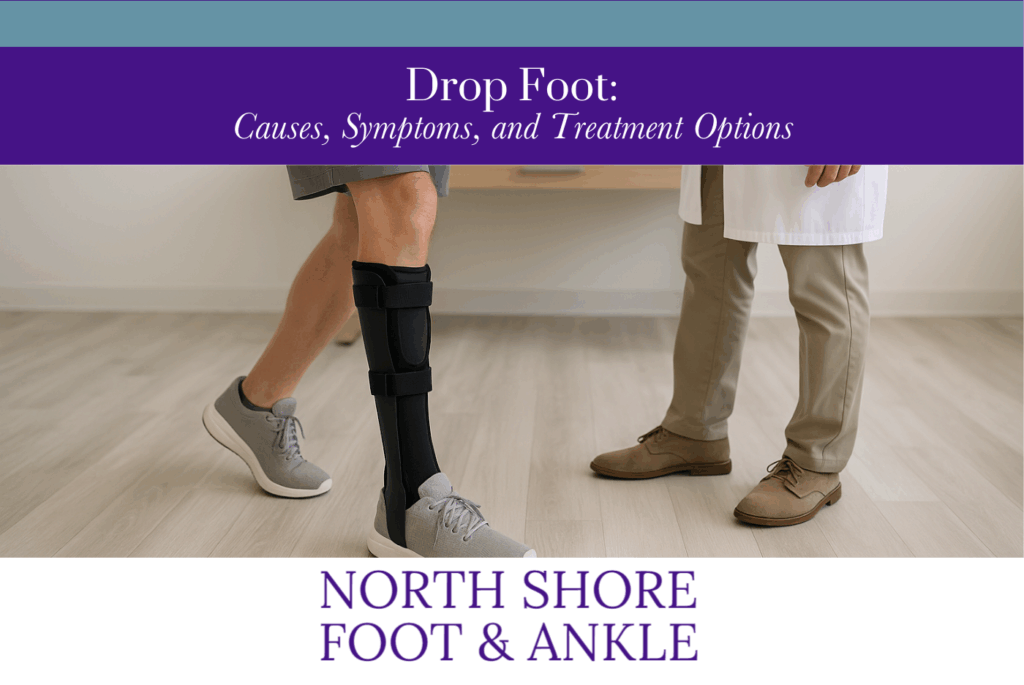
Foot health plays an essential role in overall mobility and quality of life. One condition that significantly impacts walking and balance is drop foot. At North Shore Foot & Ankle, our team of experienced podiatrists provides compassionate and advanced care to diagnose, treat, and manage this condition across all of our New York locations.
What Is Drop Foot?
Drop foot (also called foot drop) is not a disease itself but rather a sign of an underlying neurological, muscular, or anatomical problem. It is characterized by difficulty lifting the front part of the foot, leading to dragging while walking. Patients often compensate by lifting their knees higher than usual in what’s known as a steppage gait.
Common Causes of Drop Foot
- Nerve injury: Compression or damage to the peroneal nerve, often from injuries, surgeries, or prolonged sitting.
- Neurological conditions: Disorders such as multiple sclerosis (MS), stroke, amyotrophic lateral sclerosis (ALS), or cerebral palsy.
- Muscle disorders: Muscular dystrophy and other degenerative muscle conditions.
- Spinal conditions: Herniated discs or spinal stenosis affecting nerve function.
Signs & Symptoms
- Difficulty lifting the front of the foot while walking
- Tripping or dragging the toes
- Steppage gait (lifting the leg higher to clear the ground)
- Numbness or tingling in the foot or leg
- Muscle weakness in the lower leg
Treatment Options at North Shore Foot & Ankle
The right treatment depends on the underlying cause. At North Shore Foot & Ankle, we may recommend:
- Braces or splints: Ankle-foot orthotics (AFOs) help keep the foot in a normal position.
- Physical therapy: Strengthening and stretching exercises improve mobility and reduce fall risks.
- Nerve stimulation: Functional electrical stimulation (FES) can improve muscle activity.
- Surgery: In some cases, tendon transfers or nerve surgeries may be needed.
- Addressing root causes: Managing spinal issues, nerve compression, or underlying diseases.
Drop Foot: Q&A
Q: Is drop foot permanent?
A: Not always. Some cases improve with treatment, especially when the cause is temporary nerve compression. Chronic neurological conditions may require ongoing management.
Q: Can orthotics really help?
A: Yes. An AFO brace is one of the most effective tools for stabilizing the foot and preventing trips or falls.
Q: When should I see a podiatrist for drop foot?
A: If you notice difficulty lifting your foot, frequent tripping, or new weakness in your leg, schedule an appointment immediately. Early diagnosis improves outcomes.
Q: Does drop foot only affect older adults?
A: No. While more common with age and certain neurological conditions, drop foot can occur at any age due to injuries or surgery.
Q: Can physical therapy cure drop foot?
A: Physical therapy can significantly improve function and strength, but the outcome depends on the underlying cause.
Why Choose North Shore Foot & Ankle?
With five convenient New York offices, our expert podiatrists provide personalized care for conditions like drop foot. We focus on improving mobility, preventing complications, and restoring independence.
Contact North Shore Foot & Ankle
Website: northshorefootandankle.com
📍 Lynbrook Podiatry Office
50 Hempstead Ave, Ste B
Lynbrook, NY 11563
📞 (516) 599-0302
📍 Syosset Podiatry Office
175 Jericho Turnpike, Suite 300
Syosset, NY 11791
📞 (516) 496-7676
📍 Flushing Podiatry Office
72-03 164 St.
Flushing, NY 11365
📞 (718) 591-3320
📍 Rosedale Podiatry Office
140-04 248 St
Rosedale, NY 11422
📞 (718) 949-4844
📍 Plainview Podiatry Office
1144 Old Country Rd
Plainview, NY 11803
📞 (516) 942-0620
Take the Next Step
If you or a loved one is experiencing symptoms of drop foot, don’t wait. Contact North Shore Foot & Ankle today to schedule a consultation. With the right diagnosis and treatment, you can take steps toward better mobility and a more active life.








